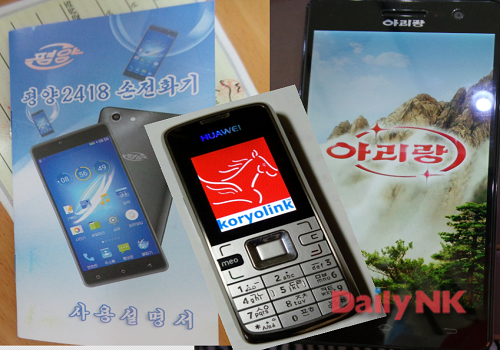Unification Media Group (UMG): Talk of increasing cellphone purchases is swirling around North Korea. Today, we will take a look at the models that are available to North Koreans, and how cellphone use is transforming the daily lives of people in the country. For more, we turn to special economic reporter Kang Mijin.
Kang Mi Jin (Kang): Cellphone usage is so widespread in South Korea that even kindergartners walk around using cellphones to communicate with their parents. North Korea is still quite far from this level of usage. However, the number of consumers using portable communications devices continues to climb. The number of cellphone subscribers began to increase in 2010, and at the beginning of this year, crossed the 3.7 million person mark. There is an estimated 25 million people in North Korea, according to the CIA World Factbook.
The rise is indicative of the North Korean people’s growing thirst for avenues to access and spread information. The fact that consumers can afford the phones and subscriptions also indicates that personal wealth for some in the country is increasing. In the beginning of 2010, only 17% of North Koreans were subscribers. According to the Egyptian firm Orascom that was involved in a joint venture to launch cellphone service in North Korea, the number of users jumped from 530,000 in March 2011 to 660,000 in June 2011.
UMG: To what extent do these increasing cellphone subscription rates indicate an improvement in the general standard of living?
Kang: North Korea experienced a famine in the 1990s, which had marginally improved by the early 2000s. Starting in 2010, on the back of growth generated by the grassroots establishment of jangmadang marketplaces, increasing portions of the North Korean population began to acquire some degree of personal wealth. As they acquired more free time and some capital, more and more North Korean residents became interested in cell phones as an asset for market trading. Cell phones are an instrumental tool for traders who need to access information, manage prices, track distribution, and keep in touch with contacts.
These days, cellphones have become a symbol of wealth, prompting even more North Koreans to purchase them. The cellphone industry, noticing this trend, is starting to design phones that match the tastes of the various demographic target groups, and new models are continuously being released.
UMG: What types of models are being released these days?
Kang: To list a few of the newer smartphone models, we include the Jindallae, the Arirang 161 and 171, the Pyongyang 2417 and 2419, the Gold Arirang, the Aegi Tachi [Baby Touch], and the Double-sided Tachi Arirang FP68. Previously, most North Koreans used flip phones, but starting in 2013, tachi pon [smartphones] began to catch on.
You mentioned before that cellphones have become status symbols. One piece of evidence in support of this is the fact that some college students who can’t even afford to pay the subscription fee to keep their phone active nonetheless carry it around to show it off.
UMG: Can you explain how the models have changed over time and which features are the most popular right now?
Kang: When the phones first came onto the market in force around the beginning of 2010, they were primarily flip phones and slider phones. Smartphones began to hit the markets in 2014. Since then, the country has continued to experiment with new designs and models. The most popular models right now are the double-sided phone, the Aegi Tachi, and the Gold Arirang.
The Gold Arirang has a gold interior side. The Aegi Tachi is a smartphone designed for children to use, from kindergarten to middle school.
Cellphone producers are experimenting with size and design in order to appeal to the younger generation. The small and catchy Aegi Tachi is aimed at this market, and is particularly popular amongst young girls. The model is also attracting interest from university students, workers, and market traders. The source explained that the Aegi Tachi is a bit cheaper, but still has all the fundamental features. This makes it popular.
UMG: Manufacturers seem to be quite sensitive to consumer demand. Can you tell us about the pricing for these new phones?
Kang: I’ll list the prices of phones in the country’s northern markets. But geographical variation might also apply. In North Hamgyong Province, the cheapest phone sells for about 500 yuan (about US $75), and there are models with better features that sell for 700 yuan, 1100 yuan, 1500 yuan, and 2100 yuan (US $315). There are even luxury models that cost 3,000-4,000 yuan ($450-600).
There are also different sim cards available at different subscription rates. The source explained that they don’t just give consumers the sim card for free. Expensive sim cards sell for 75 yuan (US $11), while cheaper ones are available for just 10 yuan ($1.50).
Adding up all these costs in North Korean money, it’s about 650,000 KPW-5.5 million KPW (approximately US $81 – $690). This is enough to purchase between 115 kilograms – 1 ton of rice. Having enough spare money around to purchase a cellphone, therefore, is an indicator of wealth and a sign of some economic improvement since the time of the famine. It also suggests a rise in the standard of living among the residents.


















